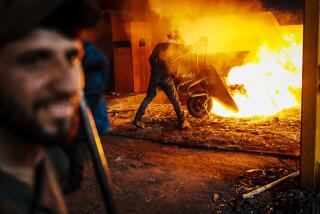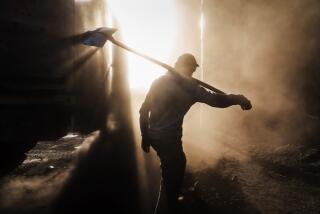Afghan Fighter Sure of Peace ‘This Time’
- Share via
JALALABAD, Afghanistan — For most of his adult life, Shirzai Mohammed has worked at what he calls a pretty routine job, as predictable and tedious as life on a factory assembly line. He gets up early, says his prayers and goes to war.
“It’s just what I do,” he said, hunkered in the dust of Tora Bora the other day, cradling his Russian-made Kalashnikov rifle with more open affection than he would dare show publicly for his wife.
He wasn’t a soldier in a national army, he explained. In fact, he was really a shoe salesman. But that work was spotty. The job he does now--where the “office” is a battlefield--is steady.
“I have done this so long, I think maybe I have forgotten how to sell shoes,” said Mohammed, 42, who has seven uneducated children and goes into battle wearing plastic sandals, with a brown blanket thrown over his street clothes.
He counts off on his fingers the enemies he has fought: the Soviet Union; the Soviet-backed government in the capital, Kabul; the Taliban; and now the Al Qaeda terrorists of Osama bin Laden. His work has spanned 15 years.
“Of course I am tired of fighting,” he said, “but the world and our neighbors never gave us time for peace. They are always stirring trouble. Now, when Al Qaeda is gone, maybe we can have peace. This time all the world supports peace in Afghanistan.”
Like many thousands of other Afghan moujahedeen who have a reputation as fierce warriors, Mohammed’s loyalty is to his tribal chieftain--in this case, Mohammed Zaher of the majority Pushtun ethnic group--but his heart belongs to Afghanistan.
He would do anything, he said, to protect his country, and he is suspicious of outsiders, especially Saudi-born Bin Laden, who recruited religiously fanatic Arabs and other foreigners to be trained in these mountains as terrorists for wreaking havoc around the world.
“If Bin Laden wants to stand up to the West,” Mohammed said, “let him go to Palestine. Why does he come to Afghanistan to ruin my country?”
From the snow-clad peaks of Tora Bora, a howling wind spilled down the ravines and across the plateau on which Mohammed waited, bringing with it the stab of winter cold. A blue Toyota pickup full of moujahedeen rolled slowly by.
“Hey, wait!” Mohammed yelled, jumping up and running after it.
He grabbed the tailgate, got a foot on the rear fender and hoisted himself aboard. Soon he disappeared in a cloud of dust, headed up the mountain toward the battlefield. Another day at the office.
The moujahedeen who fought the Taliban and Al Qaeda at Tora Bora, Mazar-i-Sharif and Kandahar are an unlikely looking band of warriors. They don’t salute, and if they are lucky enough to have shoes, they don’t shine them. They don’t carry field radios, maps, rations, ponchos, dog tags or cold-weather gear, and they don’t wear helmets, flak jackets or matching uniforms.
One went up to Tora Bora the other day in a fatigue jacket bearing the words “U.S. Army” on one lapel and the name “Grzybowski” on the other.
In combat, the fighters are formed into 10-man units--the rough equivalent of a squad in the U.S. Army. Fighters often switch from one “squad” to another and thus develop no esprit de corps for any particular unit.
In this war, the men don’t get to phone home and don’t have mail call, because the Taliban-run phone system was destroyed by U.S. bombers early in the war and the post office hasn’t been in operation for months. Most fighters haven’t even had a payday since the fighting began.
Pay scales and the frequency of pay are established by senior commanders, who are in essence tribal warlords in charge of fiefdoms. The United States is reported to have financially backed these commanders, and it is that money that will eventually be parceled out to the troops.
“I haven’t been paid yet, but I hope I will be,” said 18-year-old Khadarkhil, who uses only one name.
At Tora Bora, three commanders led three militias in the attack on the Al Qaeda terrorists. Each had his own zone. They coordinated strategy and tactics, but much less closely than U.S. commanders would, and a considerable amount of suspicion and competition existed among the three--Hazrat Ali, the most powerful chieftain; Haji Mohammed Zaman; and Mohammed Zaher.
They were competing for the political power that military success brings, for the attention of the United States that leads to financial reward, and for the $25-million bounty the Bush administration had placed on Bin Laden’s head. It was to the potential financial advantage of all three to convince Washington that Bin Laden was in Tora Bora.
One reason reliable information is so hard to come by in Afghanistan is that commanders can tell foreign reporters what happened in their zones, but there is no one who speaks for several commanders to present a broader picture of activity on an entire battlefield. To find that out, correspondents must track down all the commanders involved--a difficult and often impossible task--and draw their own conclusions.
More to Read
Sign up for Essential California
The most important California stories and recommendations in your inbox every morning.
You may occasionally receive promotional content from the Los Angeles Times.













